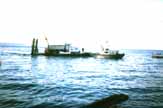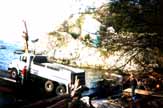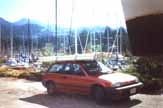
Barge arriving at Passage Island - complete with a dump-truck full of gravel.
Introduction
This was the first major construction task of Stephen and Marja once they became
proud owners of Lot #9. It was truly a test of their fortitude! They found out what was involved
and set to work. The whole task would consist of burying 150 feet (50m) of perforated pipe at the
required slope and depth. On Passage Island this is not an easy request. The
island is primarily a rock
with some earth which has accumulated over the centuries. The earth supports a dense floor covering of
English ivy with its roots intertwined in every possible space and salal - a course leathery-leafed plant.
Also there are many tree roots of the over 100 foot (33m) trees growing.
Stephen and Marja set to work, cleared and dug the channels as required. This was a long process and took about 3 months to complete. However, it was completed, and then came the days when the materials began to arrive. Their work was by no means over!
Building the Septic Field
The first task was to move a mere 8,000 lbs (3,600 kg) of course gravel from the south beach. The
photos below show the gravel arriving at the island. There are actually 13,000 lbs (5,900 kg) on the truck,
but 5,000 lbs (2,300 kg) was for Kevin and Dianne's lot. The third photo shows a small motorized wheel barrow
being loaded off the barge. This is what was used to move the gravel - barrow load by barrow load. The moving
of the gravel with this motorized cart was not without its problems! Once the completed device and cargo fell
down into a low spot.

Barge arriving at Passage Island - complete with a dump-truck full of gravel.

Truck preparing to dump its load of gravel onto the beach.

Motorized wheelbarrow being lowered onto the beach.
Stephen's truck, often known as a 1982 Honda Civic, was used to carry the pipes required for the septic field.

The pipes for the septic field arrive at the dock.
After distributing the gravel in the lines for the septic pipes, and getting the angles right for the drainage to work properly it was time to put in the pipes.